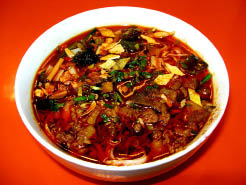
In the Han Dynasty (202 BC - AD 220), when Emperor Liu Qi (188 - 141 BC) was on the throne, a farmer in Qishan County of Shaanxi Province married a woman of many talents. Clever and virtuous, she was also adept at needlework and cooking. One day she cooked noodles for her husband’s family. The flavorful, toothsome dish won high praise, especially from her young brother-in-law, who was partial to noodles. From that day on he frequently asked his sister-in-law to make this dish. The young man later embarked on serious study with the goal of achieving scholarly honor and a career as a government official. He often became so absorbed in his books that he neglected to eat or sleep. Concerned, the young man’s kind-hearted sister-in-law frequently cooked him noodles to build up his strength. This motivated him towards even greater diligence in his studies. Years later, he went to the capital to sit the imperial examinations. Happily for him, his was among the names on the list of successful candidates, and he became a local official. One Spring Festival he invited his colleagues to dine on his sister-in-law’s specialty – noodles – at his residence. The guests were impressed by her culinary prowess. It was thus that “saozi noodles” (saozi meaning sister-in-law) got their name and became widely popular.
Today, saozi is a homonym of the dish’s original name, referring in Shaanxi dialect to the spicy sauce with fragments of meat that accompany the noodles.
To cook:
First braise the meat. Add vinegar and chili powder and fry over a medium heat until it is red and lucent. The taste – sour and hot but not pungent – is the essence of Qishan saozi noodles.
Jardinière of saozi noodles features five colors: red from carrots, green from garlic bolts, black from wood ear fungus, yellow from eggs and white from beancurd. Black and white signifies distinct attitudes towards what’s right and what’s wrong. Yellow stands for riches and honor. Red carries wishes for a better life, and green represents vitality. All the ingredients are diced and deep-fried. Their five colors express people’s wishes for a better life.
Mix flour and water to make dough. After kneading, set the dough aside for a few hours to ferment until smooth and glossy. Roll the dough into a paper-thin sheet and cut into fine noodles.
Add saozi and the jardinière ingredients to the boiled noodles and place in a bowl. Serve.
Saozi noodles have been a favorite in rural Qishan households for millennia. Years of innovation and refinement have transformed their preparation into an art.
